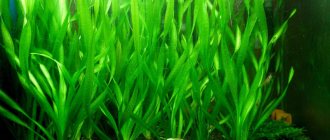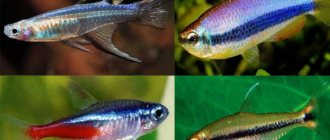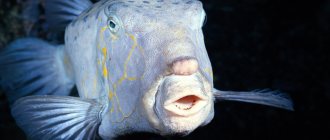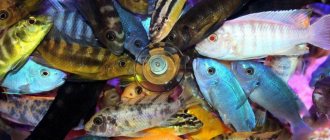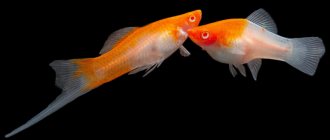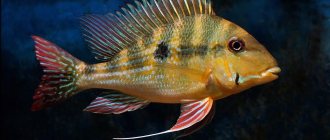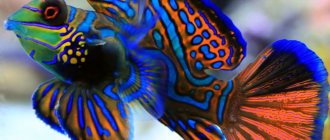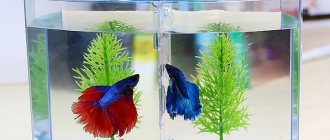Arriving at a pet store, a novice aquarist is confused by the variety of fish species and finds it difficult to make a choice. If you have no experience in breeding, then the best option is peaceful aquarium fish. Uncapricious and peaceful pets lead in popularity, as they adapt to different conditions and get along with their neighbors in the aquarium. Suitable peaceful species can be selected from the catalog of viviparous and schooling fish, catfish.
Neon
Neons are small, schooling aquarium fish with spectacular colors: along their sides there is a stripe of greenish-blue color that can reflect light. Thanks to this property, the fish seem to glow in the dark; This is how they got their name. Neons look especially advantageous against the backdrop of dense greenery in dim lighting.
Neons are kept in flocks of 6 or more. When kept alone or in pairs, fish experience stress, which shortens their lifespan. In an aquarium, neons stay in the middle and lower layers of water and never rise to the surface. In this regard, they should be fed with food floating in the water column.
Types of flocks and rules of keeping in an aquarium
In nature, fish gather in schools for protection from predators. Such movement confuses the enemy, and the statistical probability of each individual to survive is higher. They also gather in flocks for other reasons related to the availability of food or spawning behavior. In a group, fish experience less stress and do not show nervousness.
There are species of fish that are kept only in schools. This can be a simple group where all individuals are equal, and the leader appears depending on the situation. A simple flock is formed if suddenly something changes in the aquarium: new residents are introduced, food is abandoned, etc. An example of such a school is shown by neon fish. But, nevertheless, if the leader does not stand out, the individuals still stay close to each other.
In large representatives of the Kharacin family, a simple flock is formed only in juveniles. As it matures, it becomes hierarchical with one leader. Such an association is a pyramid, where the top is occupied by the strongest fish, and at the bottom are individuals that did not prove themselves in fights. An example of a hierarchical pyramid is a school of piranhas and Congo tetras.
See how the fish move in schools:
The colors of schooling fish are very variable, but with a predominance of red and black colors. Among the variety of species, glassy-transparent fish are also found, giving the artificial reservoir a special sophistication. The coloring most often determines whether an individual belongs to a schooling species. Their characteristic feature is the presence of a spot of any shape in the tail part of the body.
There is a certain rule: a multi-species aquarium contains fewer species, but more individuals of the same species.
The minimum number of fish in a school is considered to be 6-8. When you get a pair or a single fish, they radically change their character or stop being active.
Another important condition for the proper maintenance of schooling fish is the uniform distribution of species across different layers of water, their compatibility and the proportional ratio of male and female individuals. For example, in swordtails, females should prevail in number; in zebrafish, on the contrary, there should be twice as many males.
Angelfish
Angelfish are beautiful, peaceful cichlids. Their body is flattened laterally, and the fins are elongated, due to which the fish is shaped like a crescent. Natural coloring is silver with vertical black stripes; breeders have bred angelfish of black, white, marbled and other colors.
It is better to keep angelfish in a group of 6 or more individuals; required volume – from 100 liters per couple. Having reached sexual maturity, the fish split into pairs. One pair dominates the flock, but angelfish do not engage in serious fights. In an aquarium, these fish move in all layers of water, preferring to stay in the upper half of the volume.
Danio rerio
Danio rerio are small schooling fish. Their dimensions do not exceed 6 cm. The body is elongated, painted silver with longitudinal dark blue stripes.
Danio rerio is kept in groups of 6 individuals. The fish stay in the upper layers of the water and can jump out of it, so the tank should be covered with a lid. Danios do not sink to the bottom of the reservoir, so they need to be fed with food that does not sink for a long time and remains on the surface of the water. Zebrafish are unpretentious and are able to live at temperatures of 17-25°C, pH 6.7-7 and dH 6-15°. They are peaceful and suitable for a community aquarium.
Selection rules
Unpretentious fish for the aquarium are selected taking into account the following characteristics:
- Compatibility of temperaments. Look at the habits of a certain type so that conflicts do not arise.
- Required conditions. For proper settlement, the requirements for the habitat are taken into account. Comfortable temperature, acidity level and water hardness are considered.
- Adult size. Having a clear idea of what size the fish will reach will protect you from a common mistake.
- Schooling Most small fish in their natural environment live in schools. For the well-being of pets, several individuals are accommodated.
- Eating Habits The inhabitants of a body of water feed at different levels: those who feed at the surface of the water and those who obtain food from the bottom. An ill-conceived nutrition system has a detrimental effect on the health of pets.
Minor
Minor is a bright characin fish no more than 5 cm in size. The body is reddish-orange, there is a black border on the dorsal and anal fins, and there is a rounded black spot on the side behind the head.
Minors are kept in groups of 5 or more in vessels with a volume of 30 liters or more. Comfortable water parameters: temperature 22-28°C, pH 6-7.2, dH up to 15°. It is advisable to plant living plants and place driftwood in the pond. Minors are active fish; slow aquatic animals and breeds with veil fins, when kept together with minors, may suffer from their lively disposition. For these fish, neighbors with similar behavior should be selected (for example, barbs, zebrafish, neons).
Rainbows
A relatively new aquarium group of fish that gained its popularity in the 1950s. Rainbowfish are bred artificially on special farms. Aquarium fish are distinguished by their bright colors and unusual body and fin shapes. A characteristic feature of the fish of this group is a forked dorsal fin, with a noticeable gap between its two parts. The fish have gained their popularity not only due to their fancy appearance, but also because of their ease of maintenance and the possibility of a quiet life together with many popular types of fish.
There are not many varieties of iris, but the most popular are:
- Neon;
- Boesman's iris;
- Three-lane;
- Turquoise.
Sumatran barb
The Sumatran barb is a small, agile fish with a lively character. Representatives of this species reach a length of 6 cm. The color is pale golden with four vertical black stripes, the fins and head are reddish.
Barbs are introduced into a pond in a flock of 6 or more individuals. These fish can live in a smaller group, or even alone, but in this case they will show excessive aggression towards the rest of the inhabitants of the aquarium. Sumatran barbs are hardy and unpretentious, so they can be considered suitable schooling fish for a beginner's aquarium. In a reservoir, they swim mainly in the middle layers of water.
Karpov family
This family includes goldfish, zebrafish, barbs, and the rarer labeo and shark baloo. All fish from this family are peaceful and can themselves suffer from more aggressive neighbors who are attracted by luxurious tails and fins. It is probably difficult to find an aquarium where at least one of these fish is not found.
Goldfish
Veiltails, telescopes, orandas, stargazers, etc. belong to the same biological species, despite the external dissimilarity. They tolerate cool water, but become more mobile at 24-26°C. Those with unusual eyes should be kept in a separate aquarium.
Danio
There are about 30 species of zebrafish in aquariums. These are active schooling fish of very diverse colors. Thanks to the efforts of geneticists, even luminous zebrafish have appeared, but the most popular are striped ones. Peace-loving, not demanding. The aquarium should be on top as they love to jump out of the water.
Barbs
Among the barbs there are fire, cherry, black, green, variegated and striped. All are united by a peaceful disposition and unpretentiousness. Barbs are a little more difficult to breed than zebrafish.
Cherry barb
The cherry barb is a peaceful fish, not exceeding 5 cm in length. The body color is burgundy-red with a brown back and a narrow black longitudinal stripe on the side.
Cherry barbs are housed in a flock of 6 pieces in a volume of 50 liters or more. If you keep one or two fish, they will become stressed, their colors will become paler, and their health will deteriorate. Cherry barbs do not have a cocky disposition and are suitable for a community aquarium. The pond should be equipped with shelters and planted with plants so that barbs can hide in case of danger. These fish swim mainly in the upper layers of water and love diffused lighting.
Viviparous fish
Viviparous species have long earned the status of the most calm, friendly, and accommodating. Caring for them in a home aquarium is not difficult.
Mollies
Cute fish, growing up to 8-10 cm, get along well in a community aquarium with small and non-aggressive species. In order for mollies to feel comfortable, the aquarium must have shelter and a lot of plants.
Guppy
Small guppies with luxurious veil-like fins are the most sought-after species of peaceful aquarium inhabitants for beginning breeders. Fish, not exceeding 5 cm in length, feel great in a group of 5-6 individuals in a 50-liter tank. It is unacceptable to introduce large fish that can offend small pets, as well as fish that eat algae and can gnaw on guppy fins.
Swordtails
Tough, disease-resistant swordtails are common inhabitants of aquariums with abundant vegetation and sandy or pebbly soil. Its popularity is due to its unpretentiousness, bright colors, and beautiful sharp growth on the caudal fin.
Males are smaller than females, but they have a fighting character. Compatibility with other non-aggressive species is ideal, but males can fight among themselves. This happens during the spawning period, and also if the aquarium is cramped. They try to keep no more than 2 males in one tank.
Pecilia
An ideal species for a multi-species aquarium. The body length is no more than 5 cm. Platies are not capricious in care and feeding, and reproduce without problems in aquarium conditions. The fish are active, mobile, nimble, so the tank must be voluminous.
Discus
Discus fish are large, calm cichlids. They have a laterally flattened disc-shaped body up to 30 cm in size. The colors of discus fish are varied and include mainly blue, red, yellow and orange shades.
Discus fish in nature live in groups of 6-8 individuals, so in captivity representatives of this species are also kept in a school. They require a spacious home; 1 discus should contain at least 50-80 liters of water. Discus fish are shy, so the pond should be equipped with shelters and be in a quiet place. These fish are sensitive to changes in water parameters; If the conditions of detention are violated, they quickly become ill and may die.
Bolivian butterfly
Bolivian butterflies are schooling aquarium fish from the Cichlid family. They reach a length of 8 cm, have an attractive bright color and graceful elongated fins.
Bolivian butterflies are kept in groups or pairs; required volume per steam - from 80 liters. These cichlids are peaceful and suitable for a community aquarium with a water temperature of 25-28°C, pH 6.5-7.5 and dH 5-12°. Fish love diffused light; They are quite shy and need shelter and thickets of plants. Bolivian butterflies are sensitive to water quality and do not tolerate excess nitrogen and phosphate compounds in it. The aquarium must have good filtration and aeration.
Catfish
The popularity of catfish is due not only to their interesting appearance and funny behavior, but also to their benefits for the aquarium. Peaceful bottom fish perform sanitary work and clean the soil from organic residues. They are conflict-free and do not pay attention to other inhabitants.
Twig catfish
The Farlovella catfish with a thin body and a proboscis muzzle is a calm, non-pugnacious fish that will become an excellent aquarium cleaner. The main food is algae. The twig catfish must be regularly treated to zucchini and fresh herbs, otherwise it will begin to nibble on underwater vegetation. The pet is sensitive to the hardness and acidity of water, grows up to 15 cm, so a tank with a volume of at least 120 liters is required.
Otocinclus
Calm, slow-moving catfish that eat algae get along with small, inactive fish. They are cautious and timid, they feel more confident in a flock, so it is advisable to stock 5-6 individuals; a 50 liter tank with plenty of hiding places is enough for them. The delicate body of otocinclus is sensitive to temperature and water quality, so it is important to carefully monitor environmental parameters.
Ancistrus
A large, beautiful catfish, reaching 15 cm in length, is popular not only for its original coloring and cute antennae on the face of males, but also for its role as an aquarium cleaner. Ancistrus cleans the walls and decor of algae and organic plaque; the food is exclusively plant-based. Catfish are peaceful, but males occasionally start fights among themselves.
Cardinal
Cardinals are small fish that look like neons. The body length of adult individuals reaches 4 cm. The color is reddish-brown with a yellow-blue shiny stripe running along the sides.
Cardinals can live in an aquarium with a volume of 40 liters or more. A school of these fish looks impressive in bright light against the backdrop of dense vegetation. Cardinals are mobile, unpretentious, non-aggressive and are suitable for a general aquarium with a water temperature of 22-25°C, pH 6.5-7 and dH 20°. In a pond, cardinals swim mainly in the middle layers of water. Any peaceful aquatic organisms of similar size are suitable as neighbors for them.
Sick - healthy
There are only two problems with fish - domestic cats and diseases. It’s easier to protect from cats, but diseases can be brought in with fish and aquatic plants. It is better to keep newcomers in quarantine for some time, and release them into the general fish stock only after making sure that they have been cleared of bacteria, viruses, and fungi.
Diseases are divided into contagious and non-contagious. There are much more of the first – infectious and invasive. The latter occur from poor food and changes in water temperature. There are types of fish that are warm- and cold-loving; it is undesirable to keep them in the same volume.
View photos of aquarium fish diseases to quickly recognize them and remove them from healthy ones. And also carry out preventive measures in consultation with a veterinarian.
If you see that the fins are affected from all sides, transplant the fish into another container, arrange medicinal baths, and disinfect the aquarium, stones and equipment and do this regularly. If the fins are severely damaged, medications must be used. Treat plants with bicilin-5.
Tetra
Tetras are fish from the characin family. Color and size depend on the species; Tetras usually reach 4-8 cm in length, and the colors include shades of red, gold, silver and yellow.
Tetras are kept in flocks of 6 or more individuals. When kept alone, they become inactive or, conversely, begin to show aggression towards other inhabitants of the aquarium. Tetras are mobile and can jump out of the water, so the container must be covered with a lid. Lighting is preferably dim, water temperature – 24-27°C, pH 6-7, dH up to 15°. Tetras swim in the middle layers of water, and prefer to take food from its surface.
Compatibility Principles
- Keep big fish with big fish and small fish with small ones. The fish will not be eaten if they do not fit into the mouth of a large neighbor.
- Choose neighbors with similar temperaments. Playful fish are comfortable in the company of equally restless neighbors, but leisurely fish are annoyed by such roommates.
- The fish must come from places with a similar habitat. The permissible values of temperature, hardness, and acidity must be the same. Run two species with the same requirements, or one fancy species and another with a wide range of acceptable parameters. Consider the requirements for lighting, aquarium arrangement, water movement, and salinity.

